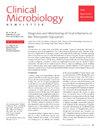A comparative analysis of Orientia Tsutsugamushi (Scrub Typhus): Essential information on causes, symptoms, and care
Q3 Medicine
引用次数: 0
Abstract
Scrub typhus is a disease caused by the bacteria Orientia tsutsugamushi, spread primarily by chiggers, which are larval mites. These mites are commonly found in Southeast Asia, including countries like India, Indonesia, and Thailand. The disease is often hard to diagnose because its symptoms—fever, headache, muscle pain, and stomach issues—are similar to other illnesses. A key sign of scrub typhus is an “eschar,” a sore that appears at the bite site. Without treatment, which typically involves antibiotics like doxycycline or azithromycin, the disease can lead to severe complications such as sepsis, shock, and multi-organ failure, with a high mortality rate. Scrub typhus has been documented in various regions, with historical records dating back to the 19th century in China. Despite advances in treatment regimen since World War II, no vaccine is available. Diagnostic methods include serological tests and PCR techniques to detect the bacteria. Preventive measures focus on avoiding areas where chiggers are prevalent and using insect repellent. Even if the scrub typhus fever has been reported from regions such as Japan to northern Australia and the Arabian Peninsula, Indian people from different parts are suffering from this endemic disease and doxycycline has become the drug of choice for the treatment of scrub typhus fever. Clinical diagnosis of scrub typhus and research related to this endemic disease must be assorted as the scrub typhus may become resistant to the current treatment regimen.
恙虫病东方体(恙虫病)的比较分析:病因、症状和护理的基本信息
恙虫病是一种由恙虫病东方体引起的疾病,主要由恙螨幼虫传播。这些螨虫常见于东南亚,包括印度、印度尼西亚和泰国等国家。这种疾病通常很难诊断,因为它的症状——发烧、头痛、肌肉疼痛和胃病——与其他疾病相似。恙虫病的一个关键症状是“疮疤”,即出现在咬伤部位的疼痛。如果不进行治疗,通常包括多西环素或阿奇霉素等抗生素,这种疾病会导致严重的并发症,如败血症、休克和多器官衰竭,死亡率很高。丛林斑疹伤寒在许多地区都有记载,历史记载可以追溯到19世纪的中国。尽管自第二次世界大战以来治疗方案取得了进展,但没有疫苗可用。诊断方法包括血清学测试和PCR技术来检测细菌。预防措施的重点是避开恙虫流行的地区并使用驱蚊剂。尽管从日本到澳大利亚北部和阿拉伯半岛等地区都报告了丛林斑疹伤寒,但来自不同地区的印度人都患有这种地方病,强力霉素已成为治疗丛林斑疹伤寒的首选药物。恙虫病的临床诊断和相关研究必须结合起来,因为恙虫病可能对目前的治疗方案产生耐药性。
本文章由计算机程序翻译,如有差异,请以英文原文为准。
求助全文
约1分钟内获得全文
求助全文
来源期刊

Clinical Microbiology Newsletter
Medicine-Infectious Diseases
CiteScore
2.20
自引率
0.00%
发文量
35
审稿时长
53 days
期刊介绍:
Highly respected for its ability to keep pace with advances in this fast moving field, Clinical Microbiology Newsletter has quickly become a “benchmark” for anyone in the lab. Twice a month the newsletter reports on changes that affect your work, ranging from articles on new diagnostic techniques, to surveys of how readers handle blood cultures, to editorials questioning common procedures and suggesting new ones.
 求助内容:
求助内容: 应助结果提醒方式:
应助结果提醒方式:


